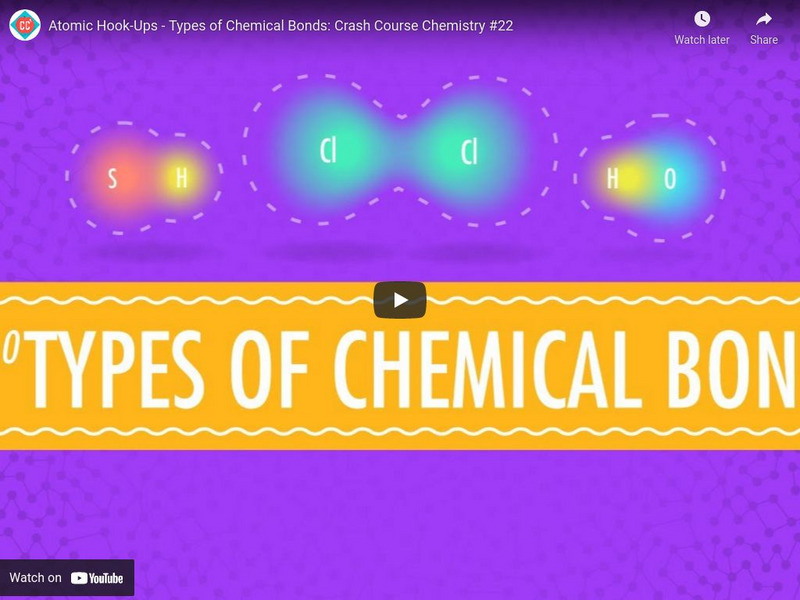Bozeman Science
Ionic Bonding
In this video Paul Andersen explains how ionic solids form when cations and anions are attracted. When atoms lose or gain electrons they form ions. The strength of the attraction between ions is based on the amount of charge and the...
Bozeman Science
Calculating the Electric Force
In this video Paul Andersen explains how you can use Coulomb's Law to determine the electric force between two charges. In Physics 1 students should be able to calculate the force between two charges and in Physics 2 students should be...
Bozeman Science
Periodicity
In this video Paul Andersen explains why atoms in the periodic table show trends in ionization energy, atomic radii, electronegativity and charge. All of these trends are explained through Coulomb's Law. A brief description of Dmitri...
Bozeman Science
Coulomb's Law
In this video Paul Andersen explains how we can use Coulomb's law to predict the structure of atoms. These predictions can be verified through the use of Photoelectron Spectroscopy (PES). Electron's are help around the nucleus because of...
SciShow
Electromagnetism - Electrostatic Force: The Four Fundamental Forces of Physics #4a
Hank reaches the fourth and final of the four fundamental interactions in physics: electromagnetism. In this part, he teaches us about the electrostatic force, which builds up a charge in an object and can travel in the form of an...
Bozeman Science
Covalent Bonding
In this video Paul Andersen explains how covalent bonds form between atoms that are sharing electrons. Atoms that have the same electronegativity create nonpolar covalent bonds. The bond energy and bond length can be determined by...
Curated Video
Electrostatic attraction
The attraction between two bodies with opposite electric charges due to the charge alone. A Twig Science Glossary Film. Key scientific terms defined in just 60 seconds using stunning images and concise textual definitions. Twig Science...
Physics Girl
Electric Charge and Light - Physics 101 / AP Physics 1 Review with Dianna Cowern
Lesson 18 (Electric Charge and Light) of Dianna's Intro Physics Class on Physics Girl. Never taken physics before? Want to learn the basics of physics? Need a review of AP Physics concepts before the exam? This course is for you!...
Catalyst University
Basics of Electrostatics of Biochemistry
Basics of Electrostatics of Biochemistry
Professor Dave Explains
IIT/JEE Chemistry Practice #19: Molecular Properties
Practice REAL problems from actual past IIT/JEE exams with Professor Dave!
Bozeman Science
PS2B—Types of Interactions
Create a unit about types of interactions that your class will be attracted to! Delve into Next Generation Science Standard PS2B with a thought-provoking video. The narrator explains how to present interactions in elementary,...
Crash Course
Electric Charge: Crash Course Physics #25
Your classes are sure to get a charge out of this lesson! A video lesson explores positive and negative electric charges related to static electricity. The instructor then moves on to a discussion of charged particles in an atom. This is...
Educreations
Electrolysis Calculations
Want to plate your baby shoe in copper? The video lesson explains the process of electroplating as a chemical procedure. Learners understand that electrolysis is the means to accomplish this goal.
SciShow
Electromagnetism - Electrostatic Force: The Four Fundamental Forces of Physics #4a
An electrifying video explains the electricity portion of the electromagnetic force. It connects everything from lightning to static electricity. Diagrams and a visual aid assist in clarifying the role of electrons to the process to...
Berkeley University of California
Ionic Bonding
This instructional video explains how bonds are formed between different atoms. It discusses valence electrons, charges, electron transfer, and Coulomb attraction. It is the second in a 15-part series.
DoodleScience
Charge, Current and Voltage
This brief video provides definitions for charge, current, and voltage and compares and contrasts these terms. The video also discusses coulomb, amps, and joules.
Crash Course
Atomic Hook-Ups - Types of Chemical Bonds
Atoms form relationships with other atoms, just like humans. Their relationships are called bonds and there are different types. Explore how energy is transferred between atoms through ionic and covalent bonds.
Flipping Physics
AP Physics 1: Electrostatics Review
AP Physics scholars will be excited to find this review of electrostatics as they prepare for the AP exam. Fast-paced, interesting, and comprehensive, the video also includes test-taking tips and common misconceptions.
Khan Academy
Khan Academy: Bohr Model Radii
An explanation that uses physics to derive the Bohr model radii. [10:52]
Khan Academy
Khan Academy: Bohr Model Energy Levels
An explanation of solving for ground state energy of electrons in regards to the Bohr model. [12:08]
Khan Academy
Khan Academy: Ionic Bonds and Coulomb's Law
Coulomb's Law is used to explain the melting point of ionic compounds. [7:32]
Crash Course
Crash Course Chemistry #22: Atomic Hook Ups Types of Chemical Bonds
Learn about how chemical bonds form in order to minimize the energy difference between two atoms or ions. Also find out the difference between covalent and ionic bonds.
Crash Course
Crash Course Physics #25: Electric Charge
Moving on to the unit on the Physics of Electricity, it's time to talk about charge. What is charge? Are there positive and negative charges? What do those things mean? In this video episode, Shini talks about electrostatic forces,...
Crash Course
Crash Course Physics #28: Electric Current
So, electric current works like a river, kinda. Instead of flowing based on elevation, electric current works a little differently. But it's a good metaphor. In this video episode of Crash Course Physics, Shini talks to us about electric...














